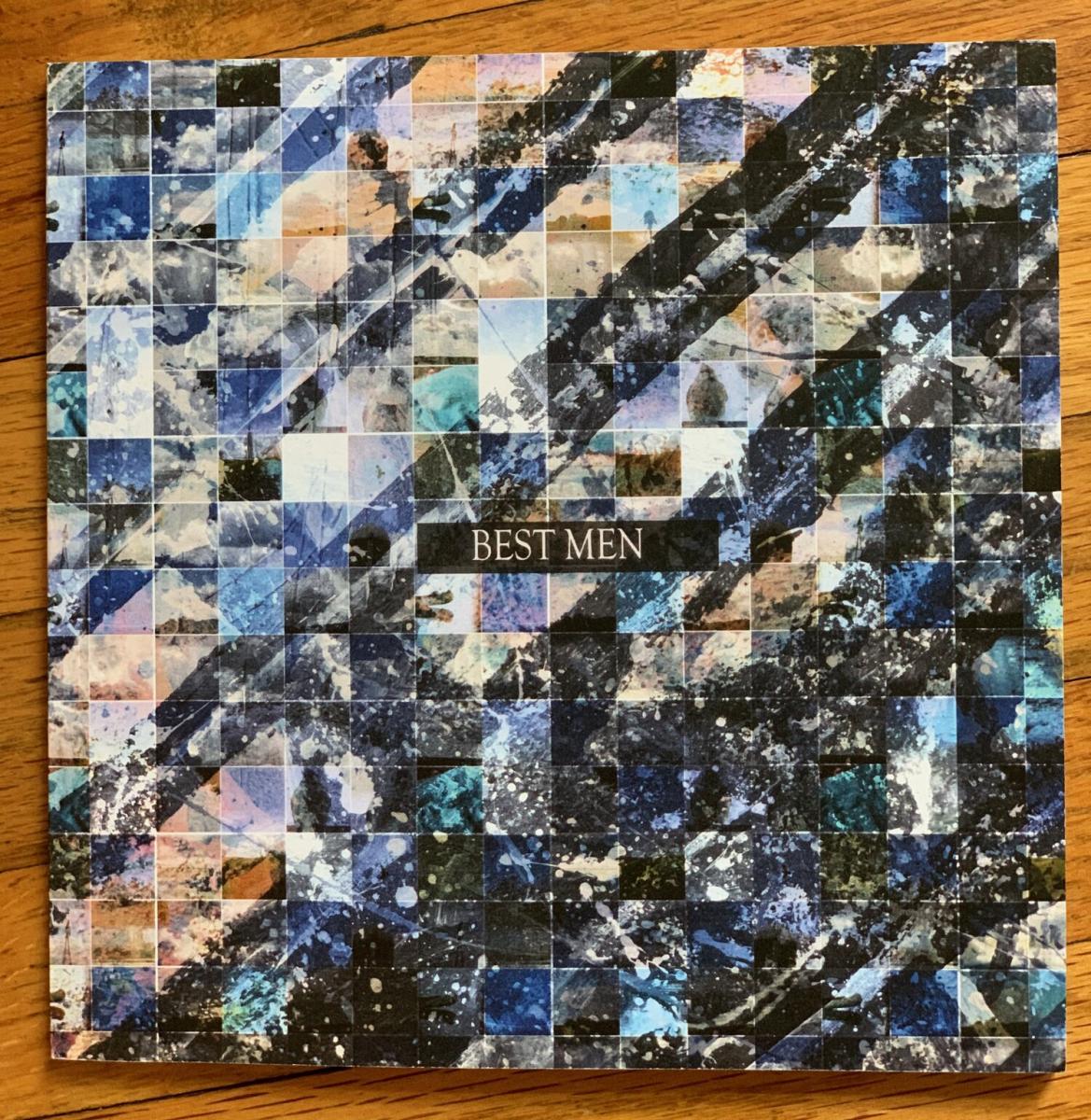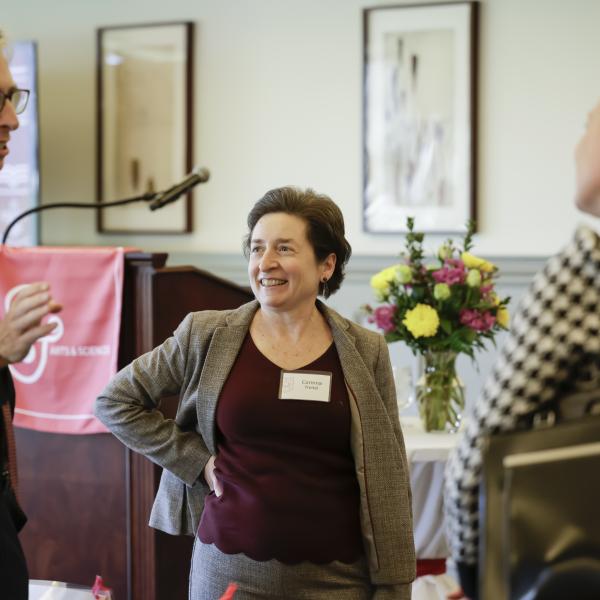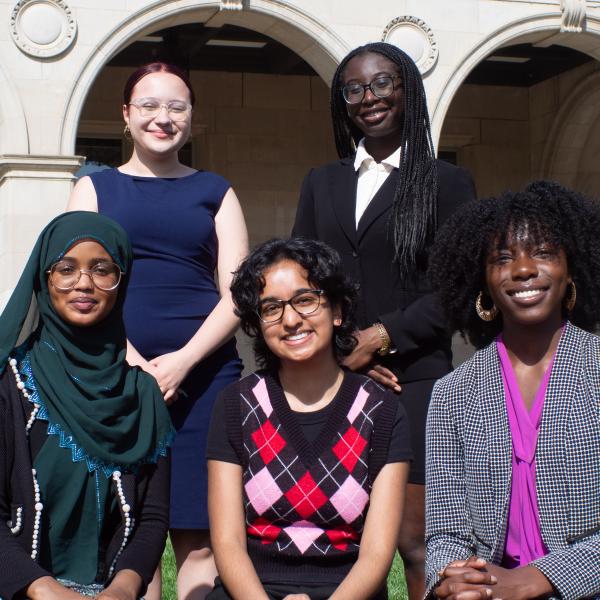Award-winning author and MFA director David Schuman's latest prose chapbook, “Best Men,” was recently published by Tammy Press. In this Q&A, Schuman talks about living in St. Louis, thwarting the expectations of readers, and why he loves teaching microfiction.
David Schuman’s Best Men simmers with observations about why people act the way they do at weddings. Over the course of five stories, Schuman introduces a cast of widely different “best men” who find themselves swept up in events beyond their control. At once surprising and suspenseful, Best Men upends popular notions of what constitutes wedding ceremonies, while also demonstrating the packed power of shorter stories.
Schuman’s stories have appeared in Fence, Conjunctions, American Short Fiction, The Missouri Review, and many other publications. He has received a MacDowell Fellowship, Pushcart Prize, a George and Anne Borchardt Scholarship to the Sewanee Writers Conference, and a Riverfront Times Mastermind Award.

Your faculty bio lists the impressively wide range of fiction you teach. When it comes to categories of fiction writing, what are the differences among the short short story, sudden fiction, microfiction, and flash fiction?
When I first started teaching a microfiction class at WashU, going back a ways, those categories were in some ways more prominent than they are now. Norton had released several anthologies. Sudden stories were thought of as being in the 1,200-to-1,500-word range, almost long enough that they could feel like “normal” stories. Flash was in the 250-to-500-word range, and microfiction was under 250 words.
I think the anthology titles were useful to categorize these stories, which at the time were starting to become popular with the rise of the internet and the growth of online publishing and social media. You might see one online magazine that was publishing stories under 300 words, another that liked stories of under 1,000. As a writer, it seemed like a good opportunity to find venues for the really short stories I was writing. And as I learned more about that, I found ways of talking about them to students from a craft standpoint.
I still do love teaching this class, because students are more willing to experiment and take risks with a shorter format. They wind up surprising themselves with their own experiments, which is hands down the most satisfying experience as a writer. But I find myself more resistant to those labels now. The names sort of cute-ify the work, but in the end, these are just stories. They're doing what fiction does. Part of learning to write is understanding the strategies for making gestures into those larger, sometimes ineffable spaces.

As a chapbook, Best Men does not fall into any of these categories. What exactly is a chapbook?
A chapbook is something larger than a pamphlet but smaller than a traditional “collection.” My favorite prose chapbooks usually feature a writer experimenting with something a little bit different than what they usually do, or maybe focusing specifically on a theme or formal conceit in a way that might feel redundant over a longer collection. For small presses, chapbooks seem to be a way to do some innovative things with design.
How did you first come up with the idea for Best Men?
I had an idea to write an abecedarian short story about best men at weddings. I had a couple ideas of lines, so I started with A, and I wrote it, and then I wrote B, and they were just little short snippets. Around that same time a good friend and I decided we would each attempt a chapbook project, and I also had the opportunity to go away for a couple days to a house in Michigan for a self-driven residency. I happened to open that file of the abecedarian story and began redrafting, except soon enough it became clear that each best man should have their own story. I like creating rules for myself, boundaries and structural ideas that will guide me in what I’m doing. For these stories, I wanted each one be about someone who was serving as a “best man” at a wedding, although they didn’t have to be “men.” I wanted to play around with genres and for every story to feel a little different. For some I relied on traditional realism, for others I went a little bit more absurd, even fantastic.
You certainly capture the differences in your choices of location. Two of your stories, "Iowa" and "Ring Bearer," feature wedding ceremonies that take place in rural, sparsely populated areas, but another story, "Sunroom," occurs within the busy confines of a nursing home. What role does setting play in your writing?
Place is always a part of the tension or conflict in a story, and in our lives. We're living in harmony with or in opposition to our surroundings, usually both. We are always either insiders or outsiders, again often both. I’m a New Jersey native so I'm an outsider even though I've been here in St. Louis for 20 years. I feel like that creates part of the tension of my life, and so that's something I'm really interested in thinking about when I write: What is the tension between a character and the place where they are?
I’m also interested in the history of a place, and how such a history impacts the characters. I read Richard McGuire’s “Here” in RAW magazine many years ago and it taught me so much about how setting impacts fiction. We exist inside of a space that countless others have occupied before us. We walk inside of histories. We're living inside of that history and it's impacting the way that we move about and how we live. And here in St. Louis, it’s impossible not to recognize how the history imposed on the physical city has become an impediment to living a good life for so many here.
"Place is always a part of the tension or conflict in a story, and in our lives. We're living in harmony with or in opposition to our surroundings, usually both."
The insider/outsider dynamic you describe can also be mapped onto the tension of proximity and distance. In your final story, “May,” the characters swim in the ocean, where, “From this distance, the city is nothing but a futile story mankind is telling itself.” How does narrative tension influence your storytelling?
In "May," I wanted to get very close to these characters and their interaction, to render texture and touch, but I also wanted to pull way back to try to tell a story about us and the natural world and how the natural world is always going to push back against these things that we try to do to it. I called the book Best Men because it is supposed to be about ideas of “masculinity” and “matrimony” — those ideas are just stories we tell ourselves. Best Men is meant to ask a question, as I believe all good titles should. That goes back to that line in "May." So much in life is this narrative that we've constructed and that we believe if we live up to it, we will have a happy life. But those narratives are constructs, veneers that cover up the chaos of truth. I'm always interested in how those narratives fall apart and where they fall apart and where they're just dead wrong and where they only work for a certain kind of privileged person. The narrative of the “best man,” this sort of important figure at a wedding, comes with a bunch of assumptions and I wanted to investigate those assumptions. "May" was a funny story to end with because it isn't about a wedding per se, but there is a ceremony, an offering.
"May" is crafted so well it is difficult to tell during a first reading which sentences contain clues about the fate of the characters. For example, the female protagonist “is comforted by the aqueous muttering of a broken toilet in one of the stalls” and that small detail, so easy to overlook, has unanticipated and tragic consequences for her male love interest later. All your stories contain a twist which render them even more rewarding upon reading multiple times. How do you envision or predict the reader’s experience?
I like setting up expectations and creating a sense that the “danger” is coming from one direction but then pulling the rug out from underneath that assumption and making the danger come from some other unexpected source. "May" was a strange story for me because I don’t often write in that fabulist mode. But I wanted to hold off on revealing that the story was set in a fantastical world, so I had fun leaving a trail of breadcrumbs so that once that final revelation happens, the reader recognizes they’ve seen traces of it all along. And I also love when a reader is forced to transfer their sympathies from one character to another. The man selected by the female protagonist thinks he is playing a certain role, but that role is far from his permanent outcome in the end.
Speaking of roles, one of your own roles is the director of the MFA program at WashU. What all is involved in running the nationally ranked MFA and the undergraduate creative writing concentration?
I have a lot of help, of course, from our faculty and amazing staff, especially from Shannon Rabong, the assistant director to the writing program. Our MFA program has 30 students working in three genres: fiction, nonfiction, and poetry. Just this last year we chose 15 new students from over 500 applications. I’m always excited about the incredibly talented and diverse group of students we bring to St. Louis every year. Our aim is to guide them through two very intense, fruitful years of study to prepare them for their lives as writers. Our alums are all over the literary map, winning awards and putting books out at a sort of unbelievable rate. We have several reading series, a one-night reading series, and our visiting Hurst professorship series, which brings six prominent writers from all over the world to St. Louis for residences of up to two weeks to work individually with our students and to read from their work and lecture on craft.
The undergraduate creative writing concentration is about 10 years old. We wanted to respond to the incredible enthusiasm and interest there is among WashU undergraduates for creative writing and to make these students even more a part of the vibrant creative writing culture here in the English department. There’s this wonderful cross pollination that happens between our undergraduates and our graduate writers and really everyone who is writing on campus. We have a lot of students from outside the English major who come in and are just terrific in our creative writing courses and are a big part of what makes those courses so great to teach.



